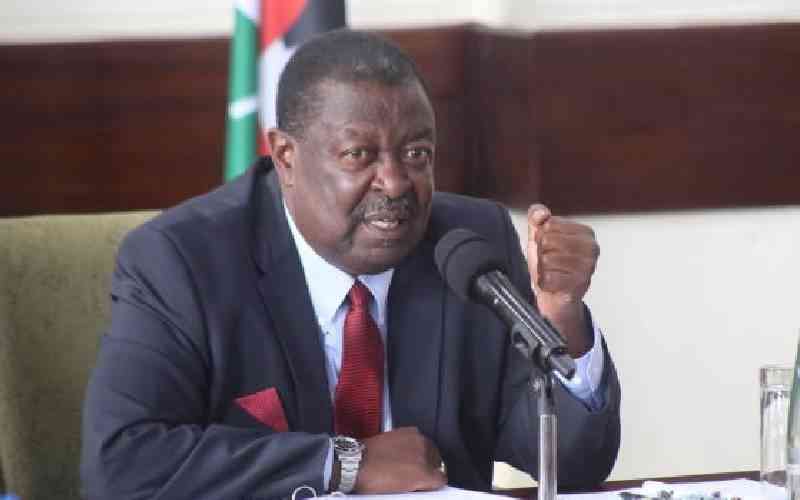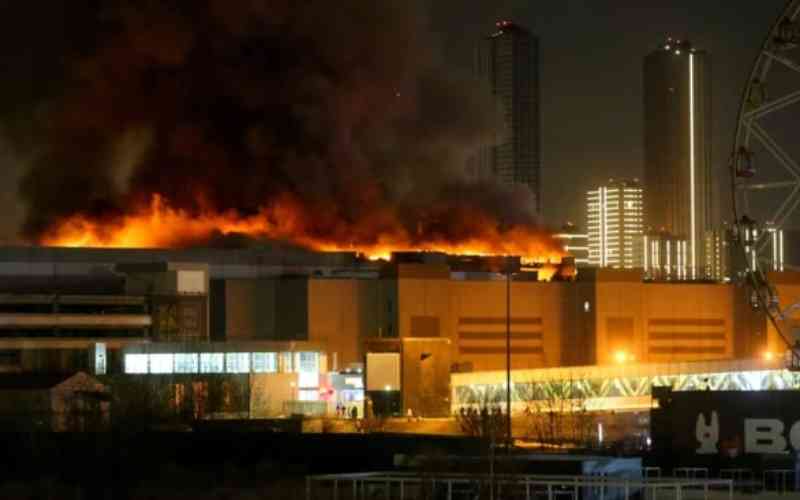 |
|
Former House Speaker Kenneth Marende [PHOTO: Courtesy] |
Despite commanding a huge block of voters the Luhya community has been seeking unity and several attempts have flopped in the past. Several factors have been attributed to this elusive unity, which include playing their political games in public, hence opening up chances of being ‘infiltrated’ by the so-called outsiders. Analysts also believe some Luhya politicians are not genuinely interested in unity.
Their huge numbers notwithstanding, politicians from the former Western and Nyanza provinces continue flip-flopping in strategy. Now, they have kicked off the New Year with intensive political activities, including drumming up that tired chorus on the elusive Luhya unity.
Mobilising voters
Politicians from the former Western Province are at it again, unleashing their campaign strategies and “top secrets” at funerals and in public rallies.
Former Deputy Prime Minister Musalia Mudavadi and Lugari MP Ayub Savula are leading the park in loudly mobilising voters.
“One would be mistaken to think that political competitors from other regions are asleep and are probably waiting to register voters in 2017!” reacts Dr Emmanuel Manyasa, a research and policy analyst, who is a resident of the region.
In contrast, there has been increased meetings among legislators from Rift Valley and Central Kenya regions. Interestingly, those meetings are held at night and secretly.
No one talks about them nor divulges their content and intent. In these regions, registration of voters is a continuous process and mobilisation for the same is largely the duty of non-governmental organisations or community based organisations, couched as agencies for the elderly, jiggered or the poor.
With such openness and lack of potent strategy, the big question emerges: Is the larger Western Kenya able to successfully market a presidential candidate in the next General Election?
In a society divided along ethnic lines, as to whether candidates from the region can challenge President Uhuru Kenyatta and Coalition for Reforms and Democracy (CORD) leader Raila Odinga for the presidency is a question that lingers in the minds of many.
In 2007, the population largely voted based on their tribes. The same was replicated in 2013 and the ground will most certainly remain the same in 2017.
“If elections were called today, there are only two candidates ready, both in terms of a party and resources to mobilise voters. And those two are Jubilee’s Uhuru and CORD’s Raila,” says Wycliffe Oparanya, Governor of Kakamega County.
“Let nobody cheat you that leaders from the larger Luhya community are ready for elections. Our best prospects lie with 2022. If we want the presidency, we should start planning now how we will work with other communities to attain it in 2022 as no community can win on their own,” he adds.
Mr Oparanya, who was reacting to former Lugari MP Cyrus Jirongo and former Speaker Kenneth Marende’s sentiments also dismissed calls for a new political party to champion the interests of the community, including propelling them to State House in 2017.
“The other factor is that each one of us wants fame and power for himself. No one wants to support the other. We are our own worst enemies,” charges the governor.
Stay informed. Subscribe to our newsletter
Oparanya opines the formation of a party two years to an election year is insignificant, as majority of MPs from the region belong to the highest number of political parties compared to their counterparts in Jubilee coalition.
“There is Musalia’s UDF, we have Moses Wetang’ula’s Ford-Kenya, and then Eugene Wamalwa’s New Ford-Kenya. ODM is also here. There are many more. Therefore if it is a matter of a political party, Western has enough of those,” he says.
Unappealing
Talks among the Luhya community are still based on a tired song, “Luhya Unity’ which apparently has remained hollow and unappealing.
Newly appointed ODM secretary general and Budalang’i MP Ababu Namwamba shares the same view: “The talk of the Luhya not being able to unite is a myth built for political convenience.”
Ababu explains that in 2002, when Ford-Kenya’s Kijana Wamalwa teamed up with former President Mwai Kibaki and current Lands Cabinet Secretary Charity Ngilu, the Luhya voted Kibaki almost to the last man.
When ODM and PNU locked horns in 2007, they also voted Raila, almost to a man. But in 2013, they were unsure as to whether to fully support CORD headed by former Prime Minister Raila Odinga, former Vice President and Wiper Party leader Kalonzo Musyoka and Wetang’ula, as it did not offer better prospective for their future.
Ababu says this is the reason why they also voted for Musalia: “Truth be said – over 90 per cent of Musalia’s votes were from Western. So the issue is not about the community but rather the disunited leaders.”
“Luhya disunity is not real, our people are united. No day have I ever heard the Banyala fighting the Samia or Bukusu fighting Maragoli. It is the leaders who are not united,” charges Ababu.
In the meantime, the ODM secretary general doubts whether western Kenya politicians have the capacity to package and support a presidential candidate.
“We should sit and discuss that not to preach the community’s unity. We should get a candidate who can network with other leaders from different parts of the country to win the election,” says Ababu.
A quick analysis of how the current politics is shaping out is that while most regions are clear on who they have in mind as their presidential candidate come 2017, the Luhya community is not.
The 2013 election was a contest between TNA and URP on one hand and ODM, Wiper and Ford-Kenya on the other. While TNA drew its support from the larger Mt Kenya communities, URP drew up support from the larger Kalenjin communities in the Rift Valley.
CORD drew its support from the Nyanza, Western, Nairobi and coastal regions. Amani drew its largest support from Western, where its leader Mudavadi comes from.
Uhuru, Ralia and Mudavadi have declared they are in the presidential race come 2017. The scenario for 2017 is likely to be a replica of what happened in 2013. The only underlying factor is, who will amass the numbers at the ballot?
 The Standard Group Plc is a
multi-media organization with investments in media platforms spanning newspaper
print operations, television, radio broadcasting, digital and online services. The
Standard Group is recognized as a leading multi-media house in Kenya with a key
influence in matters of national and international interest.
The Standard Group Plc is a
multi-media organization with investments in media platforms spanning newspaper
print operations, television, radio broadcasting, digital and online services. The
Standard Group is recognized as a leading multi-media house in Kenya with a key
influence in matters of national and international interest.
 The Standard Group Plc is a
multi-media organization with investments in media platforms spanning newspaper
print operations, television, radio broadcasting, digital and online services. The
Standard Group is recognized as a leading multi-media house in Kenya with a key
influence in matters of national and international interest.
The Standard Group Plc is a
multi-media organization with investments in media platforms spanning newspaper
print operations, television, radio broadcasting, digital and online services. The
Standard Group is recognized as a leading multi-media house in Kenya with a key
influence in matters of national and international interest.








